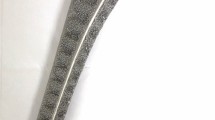Abstract.
We studied the radiographic findings on 48 hips in 48 patients to determine the stability of a proximal circumferential porous-coated femoral prosthesis in cementless total hip replacement. The patients had coxarthrosis related to acetabular dysplasia. The follow-up interval in the study was 10 to 13 years. In 36 patients, migration of the femoral component was equal to or less than 2 mm. No patient showed progressive migration. Revision surgery was performed in 37 patients because of migration of the acetabular components. Intraoperatively, no femoral components demonstrated visible motion under stress of the implant–bone interface, and none had been revised. During the follow-up period, two patients had mild thigh pain. Two others sustained fracture of the femur 11 years after surgery due to a fall. Pedestal formation was observed in 39 patients and calcar rounding in 21. The mean diameter of the medullary cavity around the distal part of the prosthesis increased from 13.6 to 16.3 mm average. We conclude that the proximal circumferential porous-coated femoral prosthesis is stable for more than ten years after surgery. The risk of subsequent periprosthetic fractures in elderly patients, however, is a matter of concern.
Similar content being viewed by others
Author information
Authors and Affiliations
Additional information
Received: April 23, 2001 / Accepted: August 19, 2001
About this article
Cite this article
Takatori, Y., Nagai, I., Moro, T. et al. Ten-year follow-up of a proximal circumferential porous-coated femoral prosthesis: radiographic evaluation and stability. J Orthop Sci 7, 68–73 (2002). https://doi.org/10.1007/s776-002-8420-1
Issue Date:
DOI: https://doi.org/10.1007/s776-002-8420-1




